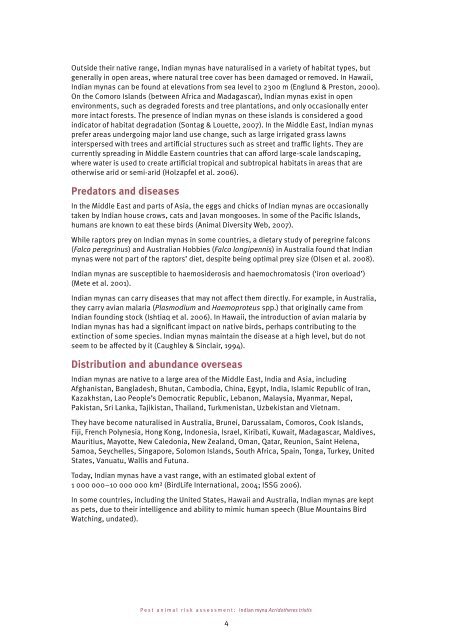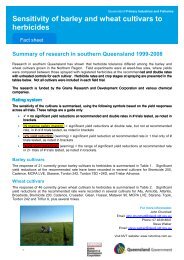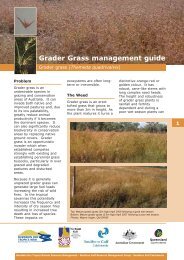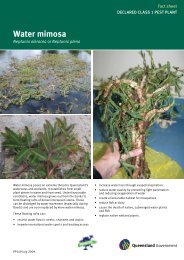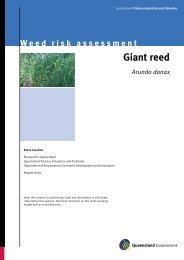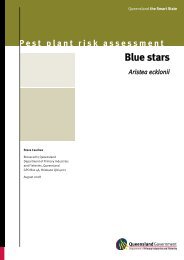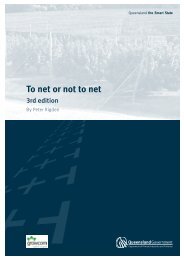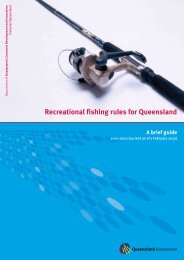Indian myna pest risk assessment - Department of Primary Industries
Indian myna pest risk assessment - Department of Primary Industries
Indian myna pest risk assessment - Department of Primary Industries
You also want an ePaper? Increase the reach of your titles
YUMPU automatically turns print PDFs into web optimized ePapers that Google loves.
Outside their native range, <strong>Indian</strong> <strong>myna</strong>s have naturalised in a variety <strong>of</strong> habitat types, but<br />
generally in open areas, where natural tree cover has been damaged or removed. In Hawaii,<br />
<strong>Indian</strong> <strong>myna</strong>s can be found at elevations from sea level to 2300 m (Englund & Preston, 2000).<br />
On the Comoro Islands (between Africa and Madagascar), <strong>Indian</strong> <strong>myna</strong>s exist in open<br />
environments, such as degraded forests and tree plantations, and only occasionally enter<br />
more intact forests. The presence <strong>of</strong> <strong>Indian</strong> <strong>myna</strong>s on these islands is considered a good<br />
indicator <strong>of</strong> habitat degradation (Sontag & Louette, 2007). In the Middle East, <strong>Indian</strong> <strong>myna</strong>s<br />
prefer areas undergoing major land use change, such as large irrigated grass lawns<br />
interspersed with trees and artificial structures such as street and traffic lights. They are<br />
currently spreading in Middle Eastern countries that can afford large-scale landscaping,<br />
where water is used to create artificial tropical and subtropical habitats in areas that are<br />
otherwise arid or semi-arid (Holzapfel et al. 2006).<br />
Predators and diseases<br />
In the Middle East and parts <strong>of</strong> Asia, the eggs and chicks <strong>of</strong> <strong>Indian</strong> <strong>myna</strong>s are occasionally<br />
taken by <strong>Indian</strong> house crows, cats and Javan mongooses. In some <strong>of</strong> the Pacific Islands,<br />
humans are known to eat these birds (Animal Diversity Web, 2007).<br />
While raptors prey on <strong>Indian</strong> <strong>myna</strong>s in some countries, a dietary study <strong>of</strong> peregrine falcons<br />
(Falco peregrinus) and Australian Hobbies (Falco longipennis) in Australia found that <strong>Indian</strong><br />
<strong>myna</strong>s were not part <strong>of</strong> the raptors’ diet, despite being optimal prey size (Olsen et al. 2008).<br />
<strong>Indian</strong> <strong>myna</strong>s are susceptible to haemosiderosis and haemochromatosis (‘iron overload’)<br />
(Mete et al. 2001).<br />
<strong>Indian</strong> <strong>myna</strong>s can carry diseases that may not affect them directly. For example, in Australia,<br />
they carry avian malaria (Plasmodium and Haemoproteus spp.) that originally came from<br />
<strong>Indian</strong> founding stock (Ishtiaq et al. 2006). In Hawaii, the introduction <strong>of</strong> avian malaria by<br />
<strong>Indian</strong> <strong>myna</strong>s has had a significant impact on native birds, perhaps contributing to the<br />
extinction <strong>of</strong> some species. <strong>Indian</strong> <strong>myna</strong>s maintain the disease at a high level, but do not<br />
seem to be affected by it (Caughley & Sinclair, 1994).<br />
Distribution and abundance overseas<br />
<strong>Indian</strong> <strong>myna</strong>s are native to a large area <strong>of</strong> the Middle East, India and Asia, including<br />
Afghanistan, Bangladesh, Bhutan, Cambodia, China, Egypt, India, Islamic Republic <strong>of</strong> Iran,<br />
Kazakhstan, Lao People’s Democratic Republic, Lebanon, Malaysia, Myanmar, Nepal,<br />
Pakistan, Sri Lanka, Tajikistan, Thailand, Turkmenistan, Uzbekistan and Vietnam.<br />
They have become naturalised in Australia, Brunei, Darussalam, Comoros, Cook Islands,<br />
Fiji, French Polynesia, Hong Kong, Indonesia, Israel, Kiribati, Kuwait, Madagascar, Maldives,<br />
Mauritius, Mayotte, New Caledonia, New Zealand, Oman, Qatar, Reunion, Saint Helena,<br />
Samoa, Seychelles, Singapore, Solomon Islands, South Africa, Spain, Tonga, Turkey, United<br />
States, Vanuatu, Wallis and Futuna.<br />
Today, <strong>Indian</strong> <strong>myna</strong>s have a vast range, with an estimated global extent <strong>of</strong><br />
1 000 000–10 000 000 km² (BirdLife International, 2004; ISSG 2006).<br />
In some countries, including the United States, Hawaii and Australia, <strong>Indian</strong> <strong>myna</strong>s are kept<br />
as pets, due to their intelligence and ability to mimic human speech (Blue Mountains Bird<br />
Watching, undated).<br />
P e s t a n i m a l r i s k a s s e s s m e n t : <strong>Indian</strong> <strong>myna</strong> Acridotheres tristis<br />
4


